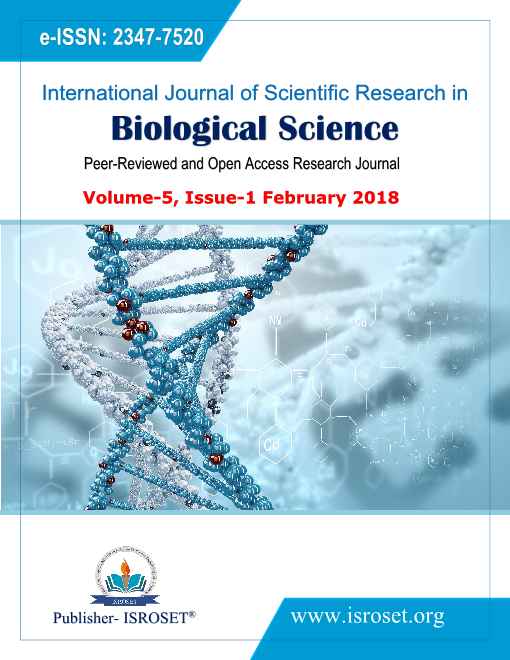In vitro Callus Induction and Preliminary Phytochemical Studies of Cissampelos pareira L
Keywords:
Cissampelos pareira, callus, growth regulators, phytochemical screeningAbstract
The present investigation was aimed to evaluate the effect of growth regulators on induction of callus from leaf segments of Cissampelos pareira. The surface sterilized young leaves were inoculated on Murashige and Skoog (MS) medium fortified with different concentration and combination of growth regulators for induction of callus. The phytochemical constituents were analyzed in the different solvent extracts using standard methods. Maximum callus induction was observed on MS medium supplemented with 2 mg/L of NAA or 2, 4-D alone and in combinations of NAA (2 mg/L) + BAP (1 mg/L) and NAA (2 mg/L) + KIN (0.5 mg/L). The preliminary phytochemical screening of leaf and leaf derived callus revealed the presence of flavonoids, alkaloids, phenols, terpenoids, coumarins etc. The developed protocol is useful for large scale production of callus from leaf explants which may be useful for isolation of important bioactive compounds for the treatment of various diseases.
References
F. Al-Bayati, K. Sulaiman, “In vitro antimicrobial activity of Salvadora persica L. extracts against some isolated oral pathogens in Iraq”, Turk J Biol, Vol. 32, pp. 57-62, 2008.
G. Rajendran, A.S. Law, R.H. Logie, M. Meulen, D. Fraser, M. Corley, “Investigating multitasking in high-functioning adolescents with autism spectrum disorders using the virtual errands task”, J Autism Dev Disord, Vol. 41, pp. 1445-1454, 2011.
R. Ashok Kumar, M. Ramaswamy, “Comparative study on the antimicrobial activity of leaf extracts of four selected Indian medicinal plants against Pseudomonas aeruginosa, Pseudomonas fluorescens, Penicillium chrysogenum and Penicillium restrictum”, Journal of Chemical, Biological and Physical Sciences, Vol. 3, Issue. 2, pp. 1376-1381, 2013.
P. Tiwari, B. Kumar, M. Kaur, G. Kaur, H. Kaur, “Phytochemical screening and extraction: a review”, Int Pharm Sci, Vol. 1, pp. 98-106, 2011.
G.B. Vaidya, Adarsha Nighantu, Chaukhambha Bharti Academy Publications, pp. 153, 1998.
A.P. Singh, A. Gupta, “Dravyaguna Vijnana”, New Delhi, Chaukhambha Orientalia, pp. 29-30, 2005.
S.K. Jain, K.A. Swadesh, K. Anurag, “Review of Cissampelos pareira Linn.”, International Journal of Applied Research, Vol. 1, Issue. 6, pp. 08-09, 2015.
K.M. Nandkarni, “Indian Materia Medica”, Popular Parakashan, Vol. 3, Issue.1, pp. 333-334, 2002.
A. Chatterjee, S.C. Prakashi, “The Treatise on Indian Medicinal Plants”, National Institution of Science and Communication and Information Resources, New Delhi, pp. 156-157, 2003.
C.P. Khare, “Indian Medicinal Plants”, Springer Private Limited, New York, 151-152, 2007.
S. Jhuma, S. Bhattacharya, “Cissampelos pareira: A promising antifertility agent”, International Journal of Research in Ayurveda and Pharmacy, Vol. 2, Issue. 2, pp. 439-442, 2011.
J.N. Tshibangu, A.D. Wright, G.M. Konig, “HPLC isolation of the anti-plasmodically active bibenzyl isoquinone alkaloids present in roots of Cissampelos mucronata. Phytochem”, Anal, Vol. 14, Issue. 1, pp. 13-22, 2003.
A. Sofowora, “Medicinal plants and traditional medicine in Africa”, Spectrum Books Ltd (Pub.), Ibadan, pp. 1-153, 1993.
G.E. Trease, W.C. Evans, “Pharmacognosy”, Bailliere Tindall, London, pp. 45-50, 1989.
C.K. Kokate, “Practical Pharmacognosy” (Vallabh Prakashan, New Delhi), Vol. 1, pp. 15-30, 1994.
J.B. Harborne, “Phytochemical Methods; A guide to Modern Technique of Plant Analysis”, 2nd ed. Chapman, pp. 100-101, 1984.
N. Raman, “Phytochemical Techniques”, New Indian Publishing Agencies, New Delhi, Vol. 19, 2006.
H. Gokul, D.H. Tejavathi, “In vitro culture and production of alkaloids in Cissampelos pareira L. Menispermaceae”, Plant Tissue Culture and Biotechnology: Emerging Trends, pp. 266-272, 1999.
V. Shad, M.A. Deepa, “Elicitation, bioconservation and quantification of berberine from Cissampelos pareira callus cultures”, International Journal of Pharmaceutical Science and Research, Vol. 6, Issue. 6, pp. 2636-2640, 2015.
D.J. Manasa, K.R. Chandrashekar, N. Bagya, “Rapid in vitro callogenesis and phytochemical screening of leaf, stem and leaf callus of Mussaenda frondosa Linn: A medicinal plant”, Asian Journal of Pharmaceutical and Clinical Research, Vol. 10, Issue. 6, pp. 81-86, 2017.
Sugandha, S. “Callus induction, antimicrobial screening and in vitro plantlet regeneration of Adansonia digitata L.: an endangered medicinal plants”, International Journal of Scientific Research in Biological Sciences, Vol. 2, Issue. 5, pp. 10-16, 2015.
Y.L. Chew, E.W.L. Chan, P.L. Tan, Y.Y. Lim, J. Stanslas, J.K. Goh, “Assessment of phytochemical content, polyphenolic composition, antioxidant and antibacterial activities of Leguminosae medicinal plants in Peninsular Malaysia”, BMC Complem Altern Med, Vol. 11, Issue. 12, 2011.
T. Arumugam, M. Ayyanar, Y.J. Koli Pillai, T. Sekar, “Phytochemical screening and antibacterial activity of leaf and callus extracts of Centella asiatica”, Bangladesh J Pharmacol, Vol. 6, pp. 55-60, 2011.
M. Johnson, E.G. Wesely, M.I. Zahir Hussain, N. Selvan, “In vivo and in vitro phytochemical and antibacterial efficiency of Baliospermum montanum (Willd.) Muell. Arg”, Asian Pacific J Trop Med, Vol. 3, pp. 894-897, 2010.
Downloads
Published
How to Cite
Issue
Section
License

This work is licensed under a Creative Commons Attribution 4.0 International License.
Authors contributing to this journal agree to publish their articles under the Creative Commons Attribution 4.0 International License, allowing third parties to share their work (copy, distribute, transmit) and to adapt it, under the condition that the authors are given credit and that in the event of reuse or distribution, the terms of this license are made clear.







